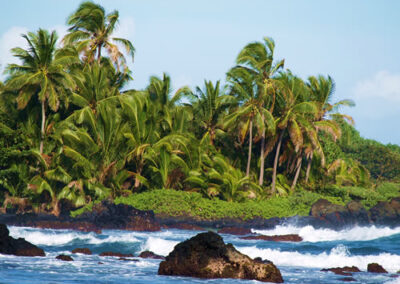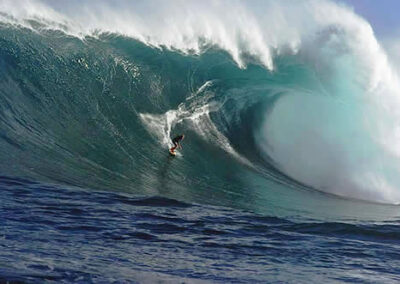Maui no ka oi (Maui is the best)
Photos courtesy Valerie Richter
The Valley Isle
Second in size of the Hawaiian Islands, Maui was created from two volcanoes, Puu Kukui (The West Maui Mountains), and the barely dormant Haleakala (its last eruption is estimated to have taken place 200 years ago, a mere instant in geological time). Named for the demi-god of Hawaiian lore, Maui is a favorite destination of travelers from all over, from Japanese couples coming to get married, to European pro windsurfers coming for the latest contest at Ho’okipa Beach.
The two volcanoes are joined by a fertile central valley, which gives the island its other name, “The Valley Island”.
The Central Valley
The main town in Maui is Kahului, a deep water port on the north side of the central valley. This is where the airport is, as well as most of the businesses. Along with Wailuku, the adjacent county seat, Kahului is the center for industrial and commercial concerns, as well as malls, shops, the hospital, etc.
Maui’s West Side
On the west side of the West Maui Mountains, down at the sea shore, is the beautiful town of Lahaina. This picturesque town is on the lee side of the island, and enjoys calm, clear waters to go along with bountiful sunshine (“Lahaina” means “merciless sun” in Hawaiian), which makes it a favorite with travelers. Set among three islands, the Lahaina ocean front offers views of Kahoolawe, Lanai, and Molokai, and world class sunsets.
Lahaina – whaler’s town
Lahaina was the center of the Hawaiian monarchy before 1843, and after the removal of the central government to Honolulu, became an important missionary center, as well as a favored rest and recreation port for the Pacific whaling trade. The whaling tradition left its mark on Lahaina, which retains some of the raffish oceanfront ambience of those days, if somewhat filtered by commercial interests.
These days, Lahaina is also remarkable for the large concentration of fine art galleries in a small area. As well as providing a great place to shop and promenade, Lahaina’s Front Street plays host to a wide selection of world class art in the space of a few blocks, and is especially fun to cruise on the weekly Friday Art Night, when the galleries vie for your attention with entertainment, free pupus (snacks), and live artists in attendance.
One event not to miss if you’re near Lahaina at the right time of year, is Halloween. Lahaina has a well-deserved reputation for putting on the best Halloween show in the Pacific – if you get a chance, don’t miss it.
The Upper West Side
North of Lahaina are the resort towns of Kaanapali, Napili, Kahana and Kapalua. These are all lovely ocean front developments with golf courses to match.
South Maui
The other major tourist destination in Maui is the Kihei-Wailea area. Set at the foot of Haleakala and facing the south shore, Kihei is the fastest growing town in Maui. Protected from rain by Haleakala, Kihei is seriously sunny, with beautiful, white sand beaches and calm, protected waters. Small wonder that Kihei is so popular with our visitors!
South of and adjacent to Kihei is Wailea, one of the Hawaii’s finest resort areas. High rent real estate, sparkling emerald water, jewel-like beaches, world class hotels and golf courses, beautiful landscaping, you get the picture.
Go further south, and you hit Makena, one of the loveliest of Maui’s beaches, and on to La Perouse Bay (named for the first westerner to set foot on Maui) an excellent snorkeling, surfing and kayaking site, as well as the end of the road.
Upcountry
Up the slopes of Haleakala above the central valley is the area that Maui folk call “Upcountry”. This runs from the small town of Ulupalukua, above Kihei, and wraps around Haleakala to Kula, Pukalani, Makawao, and Haiku. Each of these Upcountry towns has its own flavor: Ulupalakua is a ranch town, and the ambiance reflects this: As well as outrageous views of Kihei, Kahoolawe, the central valley, and Lanai, Ulupalakua has lovely green pastures, cattle, eucalyptus windbreaks, rustic western buildings and somewhat unexpectedly, a winery.
Heading north on the belt highway, the next town is Kula. Whereas Ulupalakua is rather remote from Kahului, Kula is only a twenty minute drive away, and serves as a bedroom community for some of the wealthier commuters. Blessed with bi-coastal views and a winning combination of sunshine and the coolness that altitude brings, Kula is a favorite place to live for those Maui residents that appreciate a cooler climate and can afford to pay for it. As well as being a semi rustic residential area, Kula also has protea and vegetable farms, and is home to the famous Maui onion.
Pukalani (Hole in the Heavens) is the Upcountry suburbia: Gas stations, restaurants, school, even a mall. Pukalani is a favorite place to live for those who want to keep cool, but want to be nearer to town than Kula.
Makawao and Haiku are the greener Upcountry towns. Because we’ve been following the wrap of the mountain, we are now on the windward side of the island, which means more rainfall, and the countryside reflects this fact. Makawao is the prototypical Hawaiian paniolo (cowboy) town. A very picturesque “downtown” is totally reminiscent of the old West, with false front buildings, and even hitching posts. Even today, you can see the odd horse tied up in front of the general store. However, most of the quaint storefronts cater to the tourist trade, and Makawao is an excellent place to shop for hand-made, one of a kind gifts or clothing.
Haiku is Maui’s cultural melting pot, where custom million dollar homes sit cheek by jowl with funky, run-down plantation shacks with rusty derelict cars in the front and roosters scratching in the yard. The scenery here is vividly green, with riotous bursts of color from the tropical flowers which grow everywhere. The ambience is very comfortable and laid back – a nice place to walk through and explore. Town, such as it is, consists of a post office, a couple of stores, and a couple of light industrial buildings. This is the last outpost of civilization before Hana, and the mellowing peaceful vibe that is Hana’s is starting to be felt.
Heading down the hill from Makawao is Paia. A colorful, lively town, with a very cosmopolitan air, Paia is situated on the north shore of Maui, and is convenient to the world’s best windsurfing beach, Ho’okipa. In the middle eighties, when the first adventurous windsurfers headed out to Hookipa’s waves, they initiated a revolution in the fortunes of Paia. Originally founded as a plantation town by the sugar company, Paia had come upon hard times by the late seventies. Hawaiian sugar, unable to compete with third world prices on the world market, was in a decline, and Paia was a dying town. As word got out to the international windsurfing community about the unbelievable windsurfing to be had in Maui, and Ho’okipa in particular, Maui became the premier vacation destination for windsurfers world wide, and Paia became their headquarters. Today, Paia is blessed with thriving boutiques and restaurants, and has a very enjoyable international atmosphere.
The road to lovely Hana
Heading east along the Hana highway from Paia is – you guessed it – Hana. Half the fun of Hana is getting there. The road to Hana is a tortuously winding sometimes one lane affair that covers some of Hawaii’s finest scenery – Waterfalls, bamboo forests, dramatic cliffs, sweeping bays, a new wonder behind every turn, and there are a lot of turns. Best thing is to pack a fine picnic lunch, take your time, and enjoy the trip. Once you get to Hana, it’s a lot more of the same, except the country spreads out and you’re no longer on a narrow road cut into a cliff.
Hana is the place to go to experience a green, tropical paradise with beautiful fresh water pools, waterfalls and beaches, where time stops and cares drop away.
















